October 20, 2006
Air Date: October 20, 2006
FULL SHOW
SEGMENTS
Agroterrorism
View the page for this story
When the recent outbreak of E.coli in spinach sickened people, some suspected an act of agroterrorism. Host Jeff Young talks to Peter Chalk, terrorism analyst at the Rand Corporation, about the food supply’s vulnerability to attack. (06:30)
Food Fright
/ Bruce GellermanView the page for this story
America's food supply is said to be the safest in the world, but every year nearly 80 million people in the United States become ill from contaminated food and five thousand die. Living On Earth's Bruce Gellerman investigates the problem and discovers a solution that’s surprisingly close to home. (05:30)
Big Sky, Big Election
/ Guy HandView the page for this story
Montana Senator Conrad Burns should be enjoying the incumbent's advantage. Instead, he may lose his senate seat to Jon Tester, an organic farmer and state senator. Producer Guy Hand tells us the way Montanans relate to the land is reshaping the political landscape—and could determine the race. (09:00)
Eminent Domain and Takings
View the page for this story
Voters in four Western states will decide ballot initiatives next month that could profoundly change the regulation of private property. Host Jeff Young talks with Law Professor Jim Huffman about what that might mean for environmental protection and the ability to limit sprawling growth. (06:00)
Listener Letters
View the page for this story
Listeners write to tell us they like wind energy but they’re not happy about a piece on McDonald’s Happy Meals. That and more from the mailbag. (01:30)
Emerging Science Note/Weed-Killing Robots
/ Jennifer PercyView the page for this story
Jennifer Percy reports on the new robo-weed whacker. It’s a solar powered robot that kills weeds and could cut the use of herbicides. (01:30)
Protecting Pollinators
View the page for this story
The National Academy of Sciences says important populations of pollinators may be in decline- with the potential to affect crops, ecosystems and even our economy. Host Jeff Young talks about the birds and the bees with biologist Gene Robinson, a co-author of the study. (05:00)
Don’t Bug Out
View the page for this story
Enormous insects swarmed the planet in the Paleozoic Era. Why did those bugs get so big while today’s do not? We hear from Jon Harrison, a scientist who says he has the answer, and says giant bugs will probably stay in the realm of science fiction in the future. (04:30)
Pumpkin Paddle
/ Ashley AhearnView the page for this story
After the county fair, the life of an Atlantic Giant Pumpkin doesn’t have to end in the compost pile. Dedicated fans have found that when hollowed out, these gourds make great boats. Let the races begin! Living on Earth’s Ashley Ahearn takes us to a Pumpkin Paddle. (06:00)
This week's EarthEar selection
listen /
download
Let the shucking begin! Oysters are shucked in the annual shucking competition at the Wellfleet Oysterfest in Wellfleet, Massachusetts.
Show Credits and Funders
Show Transcript
HOST: Jeff Young,
GUEST: Dr. Peter Chalk, Prof. Jim Huffman, Prof. Gene Robinson, Prof. Jon Harrison
REPORTERS: Bruce Gellerman, Guy Hand, Ashley Ahearn
SCIENCE NOTE: Jennifer Percy
[THEME]
YOUNG: From Public Radio International - this is Living on Earth.
[THEME UP AND UNDER]
YOUNG: I’m Jeff Young. How safe is our food? The numbers alone are enough to make you sick—nearly 80 million Americans will fall ill this year and some five thousand will die from contaminated food.
ACHESON: The statistics indicate that we have work to do. We’re not there yet but it is getting safer and safer all the time.
YOUNG: Top officials say we’re making progress. Others say we could do a lot better if we bought food closer to home.
HALLWEIL: What's going to make us less vulnerable to these sorts of outbreaks is depending more on smaller, more diversified farms in our area.
YOUNG: Some fresh thinking on food safety.
Also, what do you do with a giant pumpkin? Well, you could just squash it...or, you could turn it into a boat.
Carve our some time for those stories and more this week on Living on Earth – stick around.
[NPR NEWSCAST]
ANNOUNCER: Support for Living on Earth comes from the National Science Foundation and Stonyfield Farm.
[THEME]
Agroterrorism
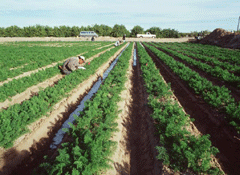
Crops may be susceptible to terrorist attacks.(Photo: USBR.gov)
YOUNG: From the Jennifer and Ted Stanley Studios in Somerville, Massachusetts - this is Living on Earth. I’m Jeff Young, sitting in for Steve Curwood.
Recent headlines about contaminated food might make you think twice about a trip through the produce aisle. Botulism in carrot juice paralyzed two people. E. Coli in spinach killed three and sickened hundreds more. The safety of our food is in question. In this segment of the program we’ll explore the problem and possible solutions.
We now know that cow manure in water was to blame for that tainted spinach. But back when people started getting sick some suspected an act of terrorism.
The officials on alert for terror attacks don’t just watch airports and skyscrapers. They also watch farms and food. A recent Congressional hearing focused on what Georgia representative John Barrow called "agro-terrorism"—an attack on the food supply.
BARROW: We have evidence that agriculture and food are potential Al Qaeda targets since 2002.
YOUNG: It’s a growing concern. This year’s FBI symposium on agro-terrorism attracted three times as many people as last year’s. Dr. Peter Chalk was a featured speaker at that FBI symposium. He’s a terrorism analyst at the Rand Corporation. Chalk says the U.S. food system is highly vulnerable. But he doubts that terrorism is the real threat.
CHALK: Well, the argument goes that if you were going to attack U.S. agriculture, it would be primarily a form of economic aggression, simply designed to cripple what is a very lucrative industrial sector. The primary motivating agenda of terrorism still remains to shock, to kill en masse, to kill with highly shocking attacks. That is necessary for publicity. It is necessary for mobilizing recruits, radicalizing existing supporters. It’s also necessary to imbue a targeted society with the type of terror and fear that extremists strive to attain.
YOUNG: So, it could really hurt us in an economic sense and could bring about deaths. But they wouldn’t be high profile, televised, really terrorizing kinds of deaths. Therefore, terrorists might not be that interested?
CHALK: Yes. I mean the impact would be significant but it would be delayed and it would lack an immediate point of contact for the media to pick up on. So that’s the first point. And merely sickening cows doesn’t really satisfy the blood lust, in my opinion, that terrorists strive to achieve.
YOUNG: So, what is it that makes us vulnerable? What are the weak points?
CHALK: If you look at the inherent nature of agriculture it is large scale and intensive, a typical dairy, at least 1500 lactating cows. They’re concentrated as herds that live in close proximity towards one another which means that diseases will quickly spread. And, in many cases, the smaller or medium scale food processing facilities often employ transient, unscreened work forces. And even basic security procedures, such as padlocking of warehouses, may not be in place.
You need to go beyond the vulnerabilities, though, if one is looking at a deliberately orchestrated attack to look at capabilities. And it’s certainly very easy to harm agriculture. Many disease agents are not infectious to humans. Which means that a perpetrator or a terrorist could handle them without any fear of accidental infection. And then because the animal itself is the weapon, in the sense that the animal would distribute the disease, there is no problem of weaponization to overcome.
YOUNG: It sounds like there are lots of points of vulnerability. Do we have any evidence that anyone has intentionally taken advantage of this? In other words, have there ever been agro-terror attacks?
CHALK: I think I’m correct in saying that since 1912 there have only been a dozen or so documented cases of the deliberate introduction of a disease agent against the food chain, of which only a handful would be termed "terroristic." I mean the best one in the U.S. context would be the introduction of salmonella by the Rajneeshi cult in Oregon in 1984, which was an attempt to influence local voter patterns.
YOUNG: They spread salmonella on salad bars, right?
CHALK: That’s correct, yeah. But beyond that there is no evidence that this has been a major focus of terrorist activity. Which goes back to my questioning this supposed Al Qaeda interest. They’re going for soft targets. They’re going for strikes that can be carried out cheaply and which offer a high degree of success. And, certainly, attacking agriculture would meet those requirements. But, for me, it doesn’t meet the requirement of shock value.
YOUNG: How do we then put this threat into context here? I mean, is the real threat here Al Qaeda getting into the food supply, or cow manure accidentally getting into the food supply?
CHALK: I think the real threat is cow manure. The real threat lies with the naturally occurring outbreak. That is what the track record has shown across the world. There have been numerous outbreaks of diseases, such as FMD, that have been naturally occurring.
YOUNG: And that’s Foot and Mouth Disease, FMD?
CHALK: Yes, it is. I mean everywhere from Taiwan right through to the UK. Other potentially worrisome diseases would be Rift Valley Fever or Exotic New Castle Disease. I think really when we’re looking at protecting agriculture I don’t think it helps to always place this in the context of terrorism. Homeland security should be viewed in much more holistic terms, it’s not necessarily only about terrorism. It’s about safeguarding critical infrastructure against all types of threats. And naturally-occurring diseases vis a vis agriculture I think are the greatest threat as opposed to a terrorist deliberately attacking that sector.
YOUNG: Dr. Peter Chalk is a terrorism analyst at the Rand Corporation. Thanks for talking with us.
CHALK: Thank you very much for having me.
Related links:
- The FDA's Center for Food Safety and Applied Nutrition
- International Symposium on Agroterrorism
- University of Nebraska’s Resources on Agroterrorism
- RAND Corporation
Food Fright
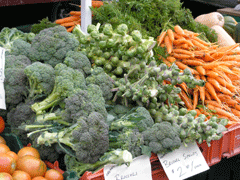
(Photo: Emily Taylor)
YOUNG: Well, you don’t have to go far to find a place ripe with food safety solutions.
[FARMER’S MARKET SOUNDS]
YOUNG: Every weekday, Nathan Sigel, owner of Tempo restaurant, shops at local farmers markets in the Boston area, keeping a sharp eye out for heirloom tomatoes. He prefers them to the ones in supermarkets.
SIGEL: They have regular, you know, pale, waxy, nasty unripe tomatoes, and they are really, really expensive. These guys, you know, have got an unbelievable product and it's a lot cheaper.

(Photo: Emily Taylor)
Living on Earth's Bruce Gellerman reports.
GELLERMAN: U.S. health officials say we have the safest food system in the world. We consume vast amounts of food with no problem at all. Still, each year, nearly 80 million people in the United States suffer from a food-borne illness. Three hundred thousand are hospitalized and five thousand die from contaminated food.
ACHESON: You're right. The statistics indicate that we’ve got work to do.
GELLERMAN: Dr. David Acheson is Chief Medical Officer of the FDA's Center for Food Safety and Applied Nutrition.
ACHESON: If you turn the clock back a number of years, it was even worse. We're not there yet. We have got more work to do. But it is getting safer and safer all the time.
GELLERMAN: But it could get worse again. Much worse. A few years ago, the Pentagon conducted a classified war game called “Silent Prairie,” simulating a bioterrorist attack with the virus that causes hoof and mouth disease. Within days, the disease had spread like wildfire. Twenty million imaginary cattle had to be destroyed. Brian Halweil is a senior researcher at Worldwatch, and author of the book “Eat Here.”
HALWEIL: And when they concluded this war game, they realized that the very aspects of our food system, which make us the envy of the world, are actually the same characteristics that make us most vulnerable. And they were very frightened and surprised by their conclusions.
GELLERMAN: American agriculture is often envied for its economies of scale—the huge farms and centralized food production and distribution facilities that make our food so inexpensive. But, according to Halweil, those are the weakest links in the American food chain. He says the system puts all of our eggs in one big basket. He cites a study showing that while the typical U.S. supermarket has about 40 thousand products on the shelf, nearly half are produced by just 10 companies. And just three companies produce the majority of the nation's meat.
ACHESON: That is one of the dilemmas of large-scale farming...and we've seen this in prior years with ground beef, for example.
GELLERMAN: Again, Dr. David Acheson of the FDA.
ACHESON: Some of the large recalls of contaminated ground beef have been because a small amount of contaminated product is then mixed with a large amount of uncontaminated product, thereby resulting in a lot of contaminated product. The same concept is potentially true of, say, some of the bagged leafy greens that we've had experience of recently.
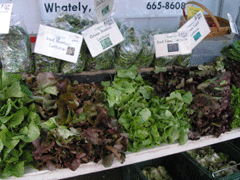
Boston leaf lettuce on sale at the local farmers’ market in Somerville, Massachusetts. (Photo: Emily Taylor)
HALWEIL: Between the Central Valley of California and the market that that lettuce ends up in, there are many opportunities along that chain for something to go wrong.
GELLERMAN: For example, says Halweil, a truck's refrigeration can break down, allowing bacteria to multiple on the produce.
HALWEIL: What's going to make us less vulnerable to these sorts of outbreaks is depending more on smaller, more diversified farms in our area. Now your small local farm isn't immune to some food safety problem, but any problem that does arise is less likely to spread to affect millions of people in dozens of states, as we've found recently in this scary spinach episode.
GELLERMAN: On this point, Dr. David Acheson of the FDA agrees.
ACHESON: If you know exactly where something's been grown and how it's been grown, those can be critical issues in insuring its safety. So it's likely to enhance your safety if you consume that product.
[FARMERS MARKET SOUNDS]
GELLERMAN: But with less than two percent of Americans involved in farming these days, the odds of knowing a farmer, especially if you live in a city, are pretty slim. But you can meet them at your local farmers market. It's where I met Chris Hartner, Farm Manager for Full Bloom Farm in western Massachusetts. There they grow 150 acres of organic produce with a watchful eye on the bottom line.

Chris Hartner shows off some of this season’s treats. (Photo: Emily Taylor)
GELLERMAN: The demand for regionally grown, organic food is soaring....sales growing at four times the rate of non-organic food. That's caught the attention of Costco and Wal-Mart which are introducing more and more organic products on their shelves. And SYSCO, the largest food distributor in North America, is also getting into the local produce business with a program it calls “Buy Local, Sell Fresh.” Craig Watson, SYSCO Vice President for Quality Assurance and Agricultural Sustainability, says as demand for locally grown produce grows, SYSCO is working with more and more small-scale farmers. It has projects in Minnesota, New Mexico and Alabama.
WATSON: We do have to help them bring their products to market to complete the supply chain because, sometimes, without making that effort, the product wouldn't get to market, or at least it wouldn't get to market on a SYSCO truck.
GELLERMAN: Locally grown produce. It's sort of back to the future to the way agriculture used to be done just a few decades ago.
For Living on Earth, I'm Bruce Gellerman.
Related link:
U.S. Food Safety
YOUNG: Coming up, the environment plays a big role in a Big Sky election. Stay tuned to Living on Earth.
[MUSIC: Smashing Pumpkins “Suffer” from ‘Gish’ (Virgin - 1991)]
Big Sky, Big Election

(Photo: Guy Hand Productions)
YOUNG: It’s Living on Earth. I’m Jeff Young. We’re following environmental issues in this year’s critical elections, and this week that takes us to Montana. Republican Senator Conrad Burns has represented Montana for eighteen years. Now polls show Burns could very well lose his seat to Democratic challenger Jon Tester, an organic farmer and president of the Montana state senate. Producer Guy Hand tells us the way Montanans relate to the land is re-shaping the political landscape in Big Sky Country.

Conrad Burns campaigning in Montana in May.(Courtesy of Burns Campaign)
HAND: U.S. Senator Conrad Burns has brought over two billion dollars in federal funds home to Montana during his three terms in office. He's helped fund scientific research, hi-tech jobs, and environmental restoration. He's also brought controversy: Disgraced lobbyist Jack Abramoff gave Burns more campaign contributions than he gave any other lawmaker in Congress. And the League of Conservation Voters has dubbed him one of their "Dirty Dozen" for a voting record they say favors the gas and oil industry.
A TV ad paid for by the Public Campaign Action Fund:
ADVERTISEMENT: (Oil CEO speaking) Things have been going great for us here at Big Oil.
[CHA CHING]
ADVERTISEMENT: (Oil CEO speaking) I love that sound! And I love your senator Conrad Burns, too! 'Cause Conrad voted for our energy bill, three point eight billion dollars in tax breaks and subsidies for us. We like having a senator we can count on.
HAND: Burns defends his vote on the energy bill saying energy independence is vital for national security. That's why he's in favor of alternative fuels and drilling in the Arctic
National Wildlife Refuge. Still, he's seven points behind in the polls.
[WALKING SOUNDS]
HAND: So, where are we?
OCHENSKI: We're on what used to be the main entrance to the capital.

Political writer George Ochenski at the Montana state capital in Helena. (Photo:Guy Hand Productions)
OCHENSKI: …and looks out across at the Helena Valley towards the Sleeping Giant that you can see on the horizon…
HAND: Political writer, George Ochenski, points to open country that, on this clear October day, seems only an arm’s length away. Even here at the capital, we're dwarfed by the landscape that surrounds us.
OCHENSKI: This is the path of the Missouri. From here, the Missouri goes down stream, and….
HAND: Montana is a large state with a small population. There are no big cities and many of its citizens live well outside even its smallest towns. Nature is in your face. But Big Sky Country, with its wealth of resources, attracts big industry. And the effects of those industries are stamped into both hard rock and memory.
Dave Peterson remembers, as a child, the first time he laid eyes on the Anaconda Mining Company’s Berkeley Pit, a vast open copper mine in Butte.
PETERSON: The pit was enormous and barren.
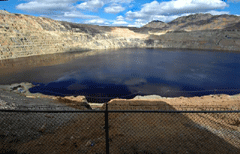
The Berkeley Pit in Butte, Montana. One of the largest Superfund sites in America, it is slowly filling with highly acidic, heavy metal laden water.(Photo: Guy Hand Productions)
PETERSON: As I grew older, the pit grew larger. And each year, or however often we drove across there and looked at it, the scar grew worse.
HAND: One of the most massive Superfund sites in America, the Berkeley Pit is a mile wide and deep enough to hide the Empire State building. It reminds Montanans of the influence Anaconda and other companies once had over the state. Again, George Ochenski.
OCHENSKI: It was referred to as Montana wearing the Copper Collar. The copper kings ran this state. They owned the newspapers, they bought the legislature, they threw bags of money through the transoms of the legislators’ rooms at night, and the people of Montana basically revolted against that in 1972.
HAND: When they re-wrote their constitution, in part. to clearly spell out the right to a clean and healthful environment, in the '70s, Montanans also passed some of the strongest state environmental laws in the nation. As the economy soured in the '80s and '90s, they rolled back many of those laws. But Theresa Keavany, director of the Montana League of Conservation Voters, says after two decades of placing jobs above other concerns, Montanans are again emphasizing the environment.
KEAVANY: In 1998, voters passed a measure to ban new cyanide leach mines. In 2000, they passed a measure to ban canned hunts and game farms. And then, in 2004, despite incredible odds, four million dollars spent to try to repeal the ban on new cyanide leach mines, voters said "no way, no how," and 58 percent said "we want that ban."
HAND: In 2004, Democratic Governor Brian Schweitzer replaced the unpopular, pro-industry Republican Judy Martz. And now, voters may soon remove their seasoned U.S. senator.
[Sound of phone bank]
HAND: Volunteers for the Montana League of Conservation Voters have gathered on this rainy Saturday morning in Billings to call voters, probe their opinions on environmental issues, and encourage them to vote for candidates like Jon Tester, Conrad Burns’s Democratic challenger. Theresa Keavany:
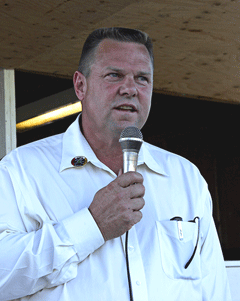
Jon Tester campaigning in June. (Courtesy of Tester Campaign)
HAND: As a state senator, Tester pushed a bill that mandates Montana move toward renewable and alternative energy sources. If elected to the U.S. Senate, he promises to create a National Renewable Energy Standard, providing incentives for wind, bio-fuels, and alternative energy. Tester scores high in the League's political rating system.
KEAVANY: His lifetime average with Montana conservation voters is 75 percent, compared to Conrad Burns’s lifetime average with the League of Conservation Voters of four percent.
HAND: Senator Burns says Tester's environmental stance is too extreme for Montana. One of his ads makes that clear.
ADVERTISEMENT: Tester is backed by radicals that want to stop logging and tear down dams. And Tester votes 92 percent with radicals who would cripple energy production in Montana. That’s who supports Jon Tester.
HAND: Yet, the most enthusiastic audience response at one recent debate in Bozeman seems to come with a question about global warming.
ANNOUNCER: Senator Burns. Global climate change.
BURNS: We've been warming since the Ice Age (groans from audience). Since the Ice Age we've been warming. And that continues. That's a pretty well known fact.
ANNOUNCER: Jon Tester.
TESTER: Earth has warmed since the Ice Age, that’s correct, but it's warming much more rapidly now than it ever has in our history.
[BIG APPLAUSE]
HAND: But Senator Burns does find support among some conservation voters.
RAPPOLD: And you've got Walling Reef right there and then you've got Old Man of the Hills right next to it.

Karl Rappold lives on the ranch on the Rocky Mountain Front his grandfather built in 1882. He is for stopping gas and oil leasing in the area, and is a vocal supporter of Conrad Burns. (Photo: Guy Hand Productions)
HAND: Rancher Karl Rappold lives along the Rocky Mountain Front. It's a stunningly beautiful place where, as he puts it, the prairie crashes right into the mountains.
RAPPOLD: I mean this is the only place left where every species of wildlife is still here that was here when Lewis and Clark came through. That says something, in itself right there.
HAND: Rappold, his well-worn cowboy hat shading a walrus mustache, points to the massive rock walls erupting along the western edge of his land. He's a life-long Republican who's been fighting against gas and oil development on the Front for decades. And that's exactly why he is voting for Conrad Burns.
RAPPOLD: Senator Burns has been very helpful to what we've been trying to do up here on the Rocky Mountain Front. He has introduced legislation that's on the appropriations bill that will permanently retire these oil and gas leases on the Front.
HAND: Senator Burns wants to reduce oil and gas drilling here by buying back drilling rights from the companies that hold them. Rappold says he'll definitely vote for Burns, but locals like Roy Jacobs aren't so sure.
JACOBS: What I'm doing is mounting a mule deer and right now I'm kind of in the finishing stages of the mount.
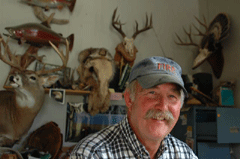
Roy Jacobs is a taxidermist in the small town of Choteau on the Rocky Mountain Front. He is for stopping gas and oil leasing in the area, but won't say who he'll vote for in the senate race.(Photo: Guy Hand Productions)
JACOBS: Probably right now I'm swinging a little bit more to the Democratic side. I think they're way more responsible. I think they're the true conservatives. They're the Teddy Roosevelt conservatives right now, I think the Democrats are.
HAND: A recent Rasmussens Reports poll says that 16 percent of GOP voters are poised to desert Burns for Tester. Roy Jacobs isn't ready to say whether he's one of them.
JACOBS: So, Senator Burns has done some good things for conservation.
HAND: Are you going to vote for him?
JACOBS: I just as soon not answer that question (laugh).
HAND: Of course, it's impossible to say how big a role the environment will play in the upcoming elections. Montanans also have sons and daughters in Iraq, worry about paychecks, hospital bills, and education. But they say they've got a special connection to this land. When asked why, their response is often a shrug and a silent nod to the open horizon, as if to say the answer is obvious.
On Montana's Rocky Mountain Front, I'm Guy Hand for Living On Earth
HAND: So who are you going to vote for? I forgot your answer.
JACOBS: I still don’t know. (laughs) Undecided at the time. I’m undecided until I go to the booth. I can’t even answer that myself.
Related links:
- Conrad Burns’ website
- Jon Tester’s website
Eminent Domain and Takings
YOUNG: Congressional and state offices aren’t the only things at stake this November.
Voters in Arizona, California, Idaho and Washington state will also decide ballot initiatives that could profoundly affect regulation of private property. Supporters say the new laws would protect property owners from government action that could take away or limit the use of land. They want to make government pay if a new regulation reduces property value. In legal jargon that’s called “takings.”
Others take aim at government’s use of eminent domain—that’s taking private property for public use. Here’s part of an ad from supporters of the item on California’s ballot. It’s called Proposition 90.
AD SOUND: After 50 years in our home, the government tried to take it away from us. They call it eminent domain. Imagine, our government taking our home and giving it to a developer!
YOUNG: Opponents say the new laws could bankrupt governments, cripple environmental protections, and bring more sprawling development. Here’s an ad they’re running in California:
AD SOUND: But it’s opposed by police, firefighters, environmentalists, business, labor, and taxpayers. More than 200 groups throughout California. Join them and vote no on 90. It’s a taxpayer trap.
YOUNG: We’ve asked an expert in constitutional and natural resource law to help us make some sense of this heated and often confusing debate. Jim Huffman is former Dean of the Lewis and Clark Law School, in Portland, Oregon.
Professor Huffman, thanks for joining us.
HUFFMAN: It’s my pleasure.
YOUNG: Professor Huffman, would these initiatives affect the ability of a state or local government to regulate to protect the environment?
HUFFMAN: Absolutely. They will have limiting effects on all kinds of regulation if that regulation impacts on property.
YOUNG: And how does that work? What’s the mechanism at play here?
HUFFMAN: Well, for example, if you had a law that was designed to protect endangered species, and a part of that regulation, the impact was that private property owners could not do certain things on their property that might impact on the endangered species, these measures presumably would require the government to pay for that diminished value that resulted from that regulation.
YOUNG: To make sure I understand this, so a state or local government would essentially be looking at a pretty high price tag in order to enforce the laws that are on the books?
HUFFMAN: That’s right. Although there’s a wide array of estimates that are made as to what it would cost. Here in Oregon we have such a measure, a compensation takings measure. So far, it doesn’t appear that that measure is having as widespread an impact as it was anticipated. I think there’s been about 3,000 claims filed. And the reality of it is, under the Oregon measure, that the government’s not paying anything because they have the alternative of waiving the regulation. That is not true in all of these pending measures. Some of them don’t give the government the option of waiving the regulation, which means they would have to come up with the money to pay for the diminished property value. And that could be very significant.
YOUNG: Apparently, as I understand it, part of the appeal of these initiatives for those signing the petitions, and, presumably, for those who might vote for them, is because of the interest in a recent Supreme Court case, a pretty high profile case from Connecticut that had to do with eminent domain. What role is that playing in these ballot initiatives’ battles out west?
HUFFMAN: Well, I think that that case, it was called Kelo against New London, Connecticut, I think that it has been a real stimulus for a focus on property rights. The Kelo case was about the use of eminent domain and that is what’s gotten the juices flowing politically. And it has, in all of these states, they have then piggybacked with that, the compensation measure which I think is much more significant, much more aggressive. So I think it has muddied the waters. And although they are both about property rights, they’re very different concerns with very different support groups, I think.
YOUNG: What I hear from the opponents to these initiatives is they see something a little more sinister at play in the scenarios you’re describing here. They see a kind of a larger effort to pretty much dismantle the regulatory mechanism. Do you see something like that at play here?
HUFFMAN: Well, I think that’s part of what’s at play. The interest groups supporting this, I think, are basically anti-regulation interest groups. But I think what has gotten this thing off the ground and made it a cause that’s been picked up all across the country is the concern about individual property owners. I think those facts in the Kelo case are what really what got this ball rolling. So I don’t think...I think it’s a mistake to conclude that this is all about a sort of a national top-down conspiracy to limit regulation. It’s partly that, but I don’t think we would be in the position we are in with these measures having a fair probability of passing, if there weren’t this grassroots concern among individual property owners that, but for the grace of God, there go I into this regulatory pit and lose the value in my property.
YOUNG: If these ballot initiatives do have some success come November, do you think we’re going to see more of these? Is this the start of a trend here?
HUFFMAN: I think so. I’ve watched the property rights movement for 25-30 years and I would say they’re on a high right now and I think they won’t stop with this.
YOUNG: Well, thanks for speaking with us today, Professor Huffman. Professor Huffman is former Dean of Lewis and Clark Law School and an expert in constitutional law and natural resource law. Thanks again.
HUFFMAN: You’re very welcome.
Related links:
- Idaho property owners
- California Voter Guide
- California No on Proposition 90
- California Yes on Proposition 90
- Washington No on Initiative 933
- Washington Yes on Initiative 933
[MUSIC: “Letters Theme” composed by Allison Lirish Dean (2001)]
Listener Letters
YOUNG: Now it’s time now to hear from you, our listeners.
[MUSIC UP AND UNDER]
YOUNG: Several people were unhappy with our story about McDonalds giving away toy Hummers in its Happy Meals.
Steve O’Donnell hears us on WNYC in New York. He says we should really have grilled the McDonalds’ spokesperson. Mr. O’Donnell wants to know how much General Motors paid McDonalds, and where the company would draw the line in marketing to children. “What’s next?” he asks. “The Marlboro Happy Meal?”
But WMFE listener, Bill Potter of Orlando, Florida, thinks the anti-Hummer argument is a non-starter.
POTTER: It’s a toy they’re giving away. I don’t know that you can tell the difference between a toy Hummer with a gas engine, a diesel engine, or a hybrid. It’s a toy for children.
YOUNG: KQED listener, Ann Kroeber in California, was inspired by our story about a Colorado brewery that chose renewable energy, even though it costs a little more. She called it “a lovely interlude from the usual gloom and doom.”
But Mike Jacobs, in Concord, Massachusetts, says that story sounds a little out of date. Jacobs is with the American Wind Energy Association. He hears us on WBUR. He says wind is now the cheap energy choice for most of Colorado, and saves money for some companies.
Well, whether you think our stories are on the money, or off the mark, let us know about it. You can call the listener line anytime at 800-218-9988; that's 800-218-ninety-nine eighty-eight. Our e-mail address is comments at l-o-e dot org. Once again, comments at L-0-E dot org.
[MUSIC: “Letters Theme” composed by Allison Lirish Dean (2001)]
YOUNG: Just ahead: row, row, row your—pumpkin? Hmm. But, first, this Note on Emerging Science from Jen Percy.
[SCIENCE NOTE THEME]
Emerging Science Note/Weed-Killing Robots
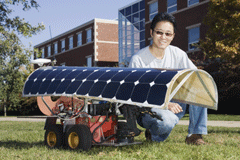
University of Illinois graduate student Hong Young Jeon with the solar-powered robot. (Photo: University of Illinois.)
PERCY: Somewhere in the Illinois countryside, a killer is on the loose. They say he has 20-20 vision, uses GPS navigation and kills his victims with a single deadly blow.
But don’t worry, he’s just a weed killer. Agricultural engineers at the University of Illinois built a search-and-destroy robot designed to roam farm fields and hunt down problematic weeds. The robot is two feet tall, is powered by solar panels, and can travel up to three miles an hour. It’s equipped with a speedy computer, an 80-gigabyte hard drive, and even has a wireless Internet connection. The computer helps identify a plant’s features, letting the robot know what is and isn’t a weed. When it finds a weed, it snips it with his robotic arm and dabs a bit of herbicide on the cut stem.

University of Illinois graduate student Hong Young Jeon with the solar-powered robot.
(Photo: University of Illinois.)
That’s this week’s Note on Emerging Science, I’m Jennifer Percy.
Related link:
University of Illinois at Urbana-Champaign’s Department of Engineering
YOUNG: Keep listening to Living on Earth.
If you enjoy listening to Living on Earth, chances are you have some pretty good ideas about things people should hear about the environment. Good news, bad news or just plain interesting. If you think it would make a worthwhile story for the radio, please get in touch. You can zap us an e-mail at comments at l-o-e dot org. Or call the Living on Earth Listener Line, at 800-218-9988. Or write 20 Holland Street, Somerville, Massachusetts 02144.
It’s Living on Earth on PRI - Public Radio International.
[MUSIC: Club D’Elf “What Would Cthuhlu Do?” from ‘Now I Understand’ (Accurate – 2006)]
Protecting Pollinators
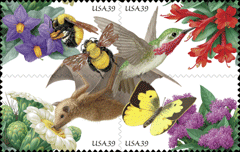
The U.S. Postal Service 2007 Commemorative Pollination Stamp. (Photo: © 2006 USPS. Used with permission. All rights reserved.)
YOUNG: It’s Living on Earth. I’m Jeff Young. It’s time you and I had a little talk about the birds and the bees.
[OPENING NOTES OF MARVIN GAYE’S “LET’S GET IT ON”]
YOUNG: Uh, no. No! Sorry. Sorry. Stop. Stop!
[MUSIC ENDS ABRUPTLY]
YOUNG: Not that kind of birds and bees talk. This kind.
[BEES BUZZING]
YOUNG: Yeah, that’s right. Real bees, real birds and the possibility that they are in real trouble. And that could be trouble for us, too. Some 80 percent of the world’s crops need birds, bees, bats, and other animals for pollination. And there are indications that some important pollinator species are in decline.
A group of concerned scientists and agriculture officials formed the North American Pollinator Protection Campaign. They asked the National Academy of Sciences to look into pollinator problems. University of Illinois biology professor Gene Robinson took part in the National Academy study and he’s with us now to talk about it.
Dr. Robinson, welcome to Living on Earth.
ROBINSON: Thank you very much. It’s a pleasure to be here.
YOUNG: What did the National Academy’s report tell us about pollinators?
ROBINSON: The report said that there is clear evidence for decline in some pollinator species. But in other cases for other species there’s just not enough information available to make that determination.
YOUNG: And, is this a serious decline? I mean, do we need to be pretty worried here, or what?
ROBINSON: Well, it’s quite a large decline. Probably about 30 percent of the population has declined over the last 20 or so years.
YOUNG: What’s causing the decline, or do we know?
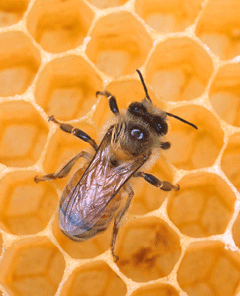
An unassuming honeybee. (Photo: Scott Bauer, USDA/ARS)
YOUNG: And what about pesticides?
ROBINSON: Pesticides are considered to be a contributing factor. The evidence is not as clearcut but there certainly is some evidence that would point in that direction. What you have, always, is a variety of factors that work to weaken populations to make them less resilient so that when other factors come into play, they can cause more serious problems.
YOUNG: What’s potentially at risk if we begin to lose significant numbers of pollinators?
ROBINSON: The effects of loss of pollinators can be severe. In agriculture there can be a disruption of our food availability. Now, just to be clear, pollinators do not pollinate the basic grain crops which are the staples of the world’s diet.
YOUNG: The wind takes care of that, right?
ROBINSON: Exactly. But pollinators do pollinate really important food crops. Nuts, fruits, berries, vegetables, seed crops—crops that add a great deal of diversity to our diet, a great deal of vitamins, nutrients that really enrich our diet.
YOUNG: Was there a, sort of a worse case scenario, just looking at the economic impact of what honeybees provide for us?
ROBINSON: Well, honeybees are estimated to provide between 10 to 20 billion dollars worth of food in the United States alone per year due to their pollination activities.
YOUNG: Wow. What then does the Academy’s report recommend we should do about this?
ROBINSON: Well, we made several recommendations. First of all, we called for more research. We note that the timing is fortuitous. The publication of the honeybee genome is just coming out. And the genome of the honeybee has been sequenced, which really is going to usher in a new era of honeybee research affording a lot of opportunities for genome-assisted research that can lead to improved strains of bees.
YOUNG: So, in addition to these things specific to honeybees there are things that you’re encouraging average people to do to get involved, right?
ROBINSON: Most pollinators are small, little creatures. So it’s possible for the average homeowner to be part of a campaign to improve the status of pollinators. All one needs to do is plant some flowering plants, create some habitat for nesting individuals, bees so that they can make their nests in these areas. So these are things that small homeowners and landowners can do on their own.
YOUNG: It just strikes me over and over the course of this conversation how much we take for granted what these little critters do for us. And I don’t know who coined the phrase, but “the little things that run the world.” They really are, aren’t they?
ROBINSON: Yes, indeed. That phrase was coined by Professor Edward Wilson who is an ant biologist, and it holds perfectly for the pollinators.
YOUNG: It greatly behooves us to pay attention and treat them right, I guess.
ROBINSON: I think so.

The U.S. Postal Service 2007 Commemorative Pollination Stamp. (Photo: © 2006 USPS. Used with permission. All rights reserved.)
ROBINSON: Thank you for having me. It was a pleasure.
YOUNG: The U.S. Postal Service hopes to raise awareness about pollinating species with a new set of pollinator stamps. You can get a sneak peek at them and read all about the birds and bees by buzzing on over to our website, it’s loe-dot-org.
Related links:
- National Academies’ Report: "Status of Pollinators in North America"
- North American Pollinator Protection Campaign
- The Pollinator Partnership
[MUSIC: Jewel Akens “The Birds and the Bees” from ‘The Birds and the Bees: The Best of Jewel Akens’ (ERA – 1994)]
Don’t Bug Out
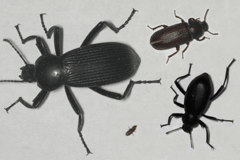
The beetles investigated in the study. From large to small: Eleodes obscura,Eleodes armata Tenebrio molitor,Tribolium castaneum (Photo: Alexander Kaiser)
YOUNG: Now we turn from little bugs to big bugs. Really big. Bugs with a two-foot wingspan. Some 300 million years ago, some insects were like that—gigantic. That we know from the fossil record. What we did not know is why those prehistoric bugs got so big and why today’s bugs, fortunately, do not.
Well, researchers from Arizona State and Midwestern Universities and the Argonne National Laboratory now think they know why. Arizona State biology professor Jon Harrison was the lead investigator. Welcome, Dr. Harrison.
HARRISON: Greetings, Jeff.
YOUNG: Tell me, what did you learn about why insects in prehistoric periods got so big?
HARRISON: Well, the link back to prehistoric time comes from work by Bob Burner (???) and others that showed that in the late Paleozoic, atmospheric oxygen was much higher than today, somewhere in the range of 30 percent oxygen. So, what we think the current working model is that you can get a larger insect with smaller trachea if the oxygen is high.
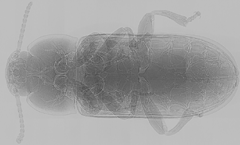
A tiled x-ray image of Tenebrio molitor. The lighter bands within the beetle are the tracheal tubes. (Photo: Alexander Kaiser and Jaco Klok.)
HARRISON: Yeah, so insects have a series of little holes along their bodies called spiracles. And then there are tubes, tiny tubes, that branch throughout their body. And the oxygen actually comes down, as a gas, right down to each tissue.
YOUNG: So, in ancient times we had 35 percent oxygen in the atmosphere?
HARRISON: Somewhere in that range.
YOUNG: And what is it today?
HARRISON: Twenty-one percent.
YOUNG: Aha. So, more oxygen in the atmosphere means the trachea didn’t have to be as big, right?
HARRISON: Exactly.
YOUNG: Well, how big can a bug get then?
HARRISON: Well, we certainly know from the fossil record that they could get up to 10 times bigger than they are today. Which, I mean a cockroach the size of your thigh would impress most people and would be considered maybe not quite like them, but a pretty scary sight.
YOUNG: And this works the other way around. Lower oxygen for at least some of these species you studied yielded smaller insects.

The beetles investigated in the study. From large to small:Eleodes obscura, Eleodes armata, Tenebrio molitor, Tribolium castaneum (Photo: Alexander Kaiser)
YOUNG: And our atmospheric concentration of oxygen has gone down a lot since 300 million years ago. Is it expected to continue to decline in the future?
HARRISON: We wish we knew. I mean it’s been constant for quite a while. So the balance between photosynthesis and respiration at the planetary level has been matched for a long time. I think it’s very interesting to look back and realize that there were periods of time where that was not the case.
YOUNG: Clearly, we’re in the realm of the hypothetical here, but if we had really big bugs, would there be big implications for the ecosystem?
HARRISON: Yeah, that’s a really fascinating question. I mean, of course, they are such great competitors that, one, I mean it’s hard to believe they wouldn’t have a tremendous effect on the ecosystem if they did get much larger. On the other hand, back when there were giant insects there weren’t birds and mammals around to eat them. So it’s not really clear who would come out on top. I’d like to hope it would be us.
YOUNG: Well, this is really kind of a fascinating topic, and I thank you very much for taking time to explain a little bit of it for us. Dr. John Harrison is a professor at Arizona State University. Dr. Harrison, thanks very much.
HARRISON: Thank you.
Related link:
American Physiological Society News Brief
[MUSIC: Bronsislau Kaper “Them! (Main Title)” from Sci-Fi’s Greatest Hits, Volume 3: The Uninvited’ (TVT – 1998)]
Pumpkin Paddle
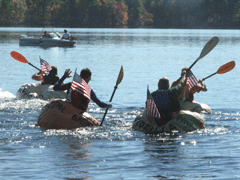
Hot off the line. Racers from left: Dan Bushnell, Tony Shirley, Joe Post, and Craig Fitzgerald.(Photo: Amy and Annette Whitehead-Pleaux)
YOUNG: Pumpkins are the most popular gourd of this festive fall season. You can carve ‘em, roast the seeds, make bread, and pie. But not all pumpkins are created equal.
This year a farmer in Rhode Island set the record for the heaviest pumpkin in the world. It weighed in at one thousand, five hundred two pounds. But after winning a weigh-off, what do you do with a giant pumpkin, but…turn it into a boat!
Living on Earth’s Ashley Ahearn went to the first annual Massachusetts Pumpkin Paddle in Rutland, and she brought back this story.
[EARLY MORNING BOAT RAMP SOUNDS, PEOPLE TALKING IN BACKGROUND]
AHEARN: 8:30 AM. It’s a misty fall morning on Long Pond and at the edge of the town parking lot, over by the boat ramp, people are unloading a few pickup trucks.
[UNLOADING SOUNDS]
AHEARN: Three men stand around sipping coffee. They look like they might be getting ready to go for an early morning boat ride, and I guess you could say they are if, by boat, you mean pumpkin.
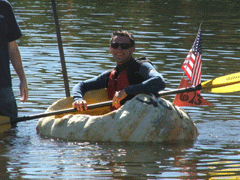
(Photo: Amy and Annette Whitehead-Pleaux)
AHEARN: In the back of Joe Post’s pickup sits a bulbous globule of gourd that would make a Hubbard squash quake on its vine.
POST: That’s the one you want to make the boat out of, right there. Six hundred pounds is what you can handle.
AHEARN: Joe’s talking about his Atlantic Giant Pumpkin. In the eastern part of this country, folks grow some of the biggest pumpkins in the world and hold competitions at state and county fairs.
Craig Fitzgerald founded the Massachusetts Pumpkin Paddle. He felt there had to be life after the county fair for Pegasus, his 400-pound, prize-winning pumpkin.
FITZGERALD: Once the weigh-offs are over, we realized that it would just go into the compost pile. There’s not much else to do with them. We decided we would paddle them, see how it does.
AHEARN: What are the qualities you would look for in a pumpkin that’s going to make a good boat?
FITZGERALD: If it were more elongated, more canoe-shaped, would be ideal, but anything between 500 and 800 pounds is an ideal weight, but mostly the shape is the most important thing.
POST: Every one is different. I had one that looked like a wagon wheel this year that was really strange looking. A lot of them get flat; they get ugly looking when they start gettin’ big. It ain’t a beauty pageant. It’s all a weigh-off, that’s what it is now.
AHEARN: Beauty pageant or not, on this day, only the mightiest of pumpkins will take to the water.
[CROWD NOISES]
AHEARN: 10:30 AM. A crowd begins to gather on the shore. In the water float four giant pumpkins. They’ve hollowed out their innards to make seats for the paddlers. They look like round, unwieldy kayaks. The worst kayaks you could ever paddle.
I found Tony Shirley. He’s one of the day’s competitors, and asked him how he prepared for the race.
SHIRLEY: You have to be serious about it. I’ve been trying a bunch of different things. Found the biggest canoe I could get, and I got a good paddle and then I was practicing standing up in the canoe, paddling, for balance purposes. I don’t know, I was thinking about getting something like a bathtub, and maybe that would work, but I couldn’t really find any.
AHEARN: Tony’s young and fit. It’s his first pumpkin paddle and he takes the race very seriously.
SHIRLEY: I mean this is the Massachusetts Pumpkin Paddle, so I will be the state champ after this, hopefully. And then maybe next year, if I win two in a row, I’ll be undefeated, and then my wife will make up the orange robe and I’ll come out with, instead of boxing gloves, I’ll have pumpkins. Don’t get me wrong, I’m here for the fun, but I’m in it to win it.
[ANNOUNCER: Well, good afternoon again everybody, and thank you for coming out to the first annual Massachusetts Pumpkin Paddle! What a great crowd! What a great afternoon…]
AHEARN: 11:30 AM. There are about 400 people now crowding the shore. The race is about to begin.
[BUGLE]
AHEARN: The competitors: Craig Fitzgerald, the quiet and humble founder of the race. Joe Post, in his camouflage hip-wader wetsuit. Young Tony Shirley rarin’ to go after weeks of training, and Dan Bushnell, a local farmer who arrives late on the scene.
I’m invited to sit in the official race committee boat, which is, thankfully, not a pumpkin, but it is a front row seat for the action.
[ANNOUNCER: Are you ready? On your mark, get set, go!!!]
[CANNON BLAST]
[ANNOUNCER: That is a blazing burst of speed that we see out here to begin this thing!” (laughs from crowd)]

Hot off the line. Racers from left: Dan Bushnell, Tony Shirley, Joe Post, and Craig Fitzgerald.(Photo: Amy and Annette Whitehead-Pleaux)
[ANNOUNCER: Big, big strokes for Dan now! He’s heading towards home!]
AHEARN: Just as Dan comes from behind to take the lead, he loses one of his competitors to the whim of a tippy gourd.
[ANNOUNCER: Oh, down goes Tony!! Down goes Tony!! He’s swimming back to his gourd.]
AHEARN: Well, Tony’s out of the race, but Dan’s about 10 yards from the finish line. Craig’s hot on Dan’s heels, and Joe is a distant third.
[ANNOUNCER: Come on, Craig, catch him!]
AHEARN: Suddenly, Joe and his pumpkin, Gourdzilla, start to teeter and take on water.
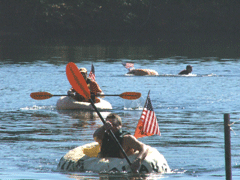
Gourd over! Tony Shirley capsizes as Dan Bushnell takes the lead, followed by Craig Fitzgerald.(Photo: Amy and Annette Whitehead-Pleaux)
[ANNOUNCER: Oh! Down goes Joe!]
AHEARN: [(Joe laughing] Joe’s in the water laughing as Dan crosses the finish line.
[ANNOUNCER: The winner of the first annual Massachusetts Pumpkin Paddle!]
[CHEERS FADED OUT]
[CELEBRATE MUSIC FADES IN LOW IN BACKGROUND]
AHEARN: After the award ceremony, I catch up with the sopping wet Tony. He’s already getting pumped for next year’s competition.
SHIRLEY: My neighbor’s gonna let me grow a pumpkin in his backyard so I’m scored on that. Maybe I’ll grow two, carve one out to practice in that. It’s hard to say, it’s hard to prepare for something like this. But there’s always next year.
[FADE UP CELEBRATE MUSIC]
AHEARN: There is indeed always next year.
[CELEBRATE MUSIC FADE UP IN BACKGROUND]
AHEARN: For Living on Earth, I’m Ashley Ahearn in Rutland, Massachusetts.
Related link:
First Massachusetts Pumpkin Paddle
[MUSIC: Kool & The Gang “Celebration (Single Version)” from ‘Celebrate!’ (UMG Recordings, Inc. – 1987)]
YOUNG: Next week on Living on Earth: California Congressman Richard Pombo controls the fate of some of the most important national environmental legislation. Well, now he’s in an election fight to keep his seat. Environmental groups hope to defeat Pombo and make way for his opponent, a wind power engineer.
MALE: What's unique about this race is the focal point on the environment and energy. Both candidates are very well-versed in energy policy. They know where they want to go, and they have laid out pretty solid policies.
YOUNG: Is Congressman Pombo an endangered species? Next week, on Living on Earth.
[EARTH EAR: “Oyster Fest Shuck-Off Shucking Contest” recorded by Bruce Gellerman in Wellfleet, Massachusetts (October 15th, 2006)]
|
|
YOUNG: Absolutely shucking! We leave you this week at another competition.
Living on Earth’s Bruce Gellerman went to a festival in Wellfleet, Massachusetts, that celebrates the food that made the place famous--oysters.
[OYSTER SHUCKING SOUNDS]
YOUNG: Living on Earth is produced by the World Media Foundation. Our crew includes Ashley Ahearn, Eileen Bolinsky, Bruce Gellerman, Ingrid Lobet, and Emily Taylor - with help from Bobby Bascomb, and Kelley Cronin. Our interns are Ian Gray and Jennifer Percy. Dennis Foley is our technical director. Our executive producer is Steve Curwood. Allison Lirish Dean composed our themes. You can find us at loe dot org. I’m Jeff Young. Thanks for listening.
ANNOUNCER: Funding for Living on Earth comes from the National Science Foundation, supporting coverage of emerging science; And Stonyfield farm organic yogurt and smoothies. Stonyfield pays its farmers not to use artificial growth hormones on their cows. Details at Stonyfield dot com.
Support also comes from you our listeners, the Ford Foundation, the William and Flora Hewlett Foundation, and the Saunders Hotel Group of Boston's Lennox and Copley Square Hotels. Serving you and the environment while helping preserve the past and protect the future, 800-225-7676.
Living on Earth wants to hear from you!
Living on Earth
62 Calef Highway, Suite 212
Lee, NH 03861
Telephone: 617-287-4121
E-mail: comments@loe.org
Newsletter [Click here]
Donate to Living on Earth!
Living on Earth is an independent media program and relies entirely on contributions from listeners and institutions supporting public service. Please donate now to preserve an independent environmental voice.
NewsletterLiving on Earth offers a weekly delivery of the show's rundown to your mailbox. Sign up for our newsletter today!
 Sailors For The Sea: Be the change you want to sea.
Sailors For The Sea: Be the change you want to sea.
 The Grantham Foundation for the Protection of the Environment: Committed to protecting and improving the health of the global environment.
The Grantham Foundation for the Protection of the Environment: Committed to protecting and improving the health of the global environment.
 Contribute to Living on Earth and receive, as our gift to you, an archival print of one of Mark Seth Lender's extraordinary wildlife photographs. Follow the link to see Mark's current collection of photographs.
Contribute to Living on Earth and receive, as our gift to you, an archival print of one of Mark Seth Lender's extraordinary wildlife photographs. Follow the link to see Mark's current collection of photographs.
 Buy a signed copy of Mark Seth Lender's book Smeagull the Seagull & support Living on Earth
Buy a signed copy of Mark Seth Lender's book Smeagull the Seagull & support Living on Earth


